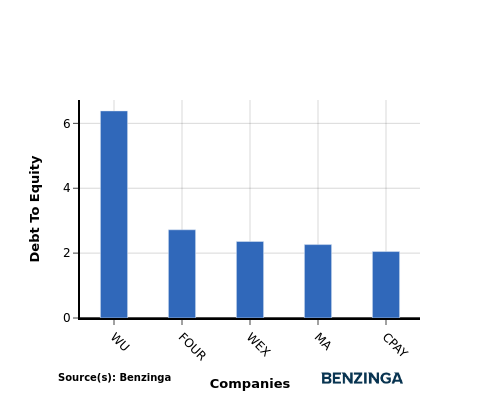In today's rapidly evolving and fiercely competitive business landscape, it is crucial for investors and industry analysts to conduct comprehensive company evaluations. In this article, we will undertake an in-depth industry comparison, assessing Mastercard MA alongside its primary competitors in the Financial Services industry. By meticulously examining crucial financial indicators, market positioning, and growth potential, we aim to provide valuable insights to investors and shed light on company's performance within the industry.
Mastercard Background
Mastercard is the second-largest payment processor in the world, having processed close to over $9 trillion in volume during 2023. Mastercard operates in over 200 countries and processes transactions in over 150 currencies.
| Company | P/E | P/B | P/S | ROE | EBITDA (in billions) | Gross Profit (in billions) | Revenue Growth |
|---|---|---|---|---|---|---|---|
| Mastercard Inc | 39.09 | 62.26 | 17.43 | 42.16% | $3.67 | $5.02 | 12.57% |
| Visa Inc | 30.71 | 14.22 | 16.54 | 11.86% | $5.84 | $6.98 | 9.89% |
| Fiserv Inc | 29.25 | 3.17 | 4.87 | 2.51% | $1.96 | $2.88 | 7.39% |
| PayPal Holdings Inc | 17.18 | 3.30 | 2.45 | 6.87% | $2.14 | $3.67 | 8.71% |
| Block Inc | 3724 | 2.45 | 2.09 | 0.98% | $0.15 | $2.03 | 24.13% |
| Fidelity National Information Services Inc | 81.88 | 2.10 | 4.19 | 1.3% | $0.66 | $0.97 | -0.59% |
| Global Payments Inc | 33.04 | 1.38 | 3.38 | 1.59% | $0.99 | $1.51 | 8.03% |
| Corpay Inc | 23.02 | 6.65 | 6.01 | 8.07% | $0.51 | $0.74 | 6.08% |
| Jack Henry & Associates Inc | 32.27 | 6.97 | 5.57 | 5.43% | $0.17 | $0.22 | 7.99% |
| WEX Inc | 35.22 | 5.10 | 3.60 | 3.66% | $0.23 | $0.39 | 6.65% |
| StoneCo Ltd | 17.76 | 1.78 | 2.36 | 4.53% | $1.13 | $2.3 | 20.35% |
| Euronet Worldwide Inc | 18.88 | 3.81 | 1.45 | 5.79% | $0.15 | $0.36 | 10.63% |
| The Western Union Co | 7.97 | 11.45 | 1.12 | 32.55% | $0.24 | $0.41 | 1.18% |
| PagSeguro Digital Ltd | 12.79 | 1.63 | 2.34 | 3.74% | $1.79 | $0.2 | 7.56% |
| DLocal Ltd | 29.31 | 9.11 | 6.69 | 6.44% | $-0.02 | $0.07 | 58.75% |
| Shift4 Payments Inc | 41.31 | 5.64 | 1.40 | 2.6% | $0.09 | $0.2 | 31.19% |
| Paymentus Holdings Inc | 115.44 | 6 | 4.23 | 2.22% | $0.02 | $0.05 | 24.68% |
| Evertec Inc | 31.76 | 4.17 | 3.64 | 2.04% | $0.06 | $0.1 | 20.29% |
| Payoneer Global Inc | 20.88 | 2.81 | 2.37 | 4.15% | $0.03 | $0.19 | 22.21% |
| Average | 239.04 | 5.1 | 4.13 | 5.91% | $0.9 | $1.29 | 15.28% |
By thoroughly analyzing Mastercard, we can discern the following trends:
-
The Price to Earnings ratio of 39.09 is 0.16x lower than the industry average, indicating potential undervaluation for the stock.
-
The elevated Price to Book ratio of 62.26 relative to the industry average by 12.21x suggests company might be overvalued based on its book value.
-
The Price to Sales ratio of 17.43, which is 4.22x the industry average, suggests the stock could potentially be overvalued in relation to its sales performance compared to its peers.
-
The Return on Equity (ROE) of 42.16% is 36.25% above the industry average, highlighting efficient use of equity to generate profits.
-
The company has higher Earnings Before Interest, Taxes, Depreciation, and Amortization (EBITDA) of $3.67 Billion, which is 4.08x above the industry average, indicating stronger profitability and robust cash flow generation.
-
With higher gross profit of $5.02 Billion, which indicates 3.89x above the industry average, the company demonstrates stronger profitability and higher earnings from its core operations.
-
The company is witnessing a substantial decline in revenue growth, with a rate of 12.57% compared to the industry average of 15.28%, which indicates a challenging sales environment.
Debt To Equity Ratio

The debt-to-equity (D/E) ratio assesses the extent to which a company relies on borrowed funds compared to its equity.
Considering the debt-to-equity ratio in industry comparisons allows for a concise evaluation of a company's financial health and risk profile, aiding in informed decision-making.
By evaluating Mastercard against its top 4 peers in terms of the Debt-to-Equity ratio, the following observations arise:
-
Mastercard is positioned in the middle in terms of the debt-to-equity ratio compared to its top 4 peers.
-
This suggests a balanced financial structure, where the company maintains a moderate level of debt while also relying on equity financing with a debt-to-equity ratio of 2.26.
Key Takeaways
For Mastercard, the PE ratio is low compared to peers, indicating potential undervaluation. The high PB and PS ratios suggest strong market sentiment and revenue multiples. Mastercard's high ROE, EBITDA, and gross profit reflect efficient operations and profitability. However, the low revenue growth may indicate a need for strategic initiatives to drive future performance in the Financial Services industry.
This article was generated by Benzinga's automated content engine and reviewed by an editor.
Edge Rankings
Price Trend
© 2025 Benzinga.com. Benzinga does not provide investment advice. All rights reserved.
Trade confidently with insights and alerts from analyst ratings, free reports and breaking news that affects the stocks you care about.